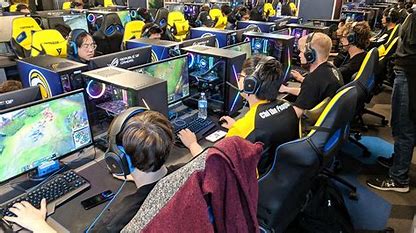Recently, the term “esports” has entered everyone’s vocabulary and gained the attention of educators, venue operators, technology managers and parents who are scrambling to understand this “new” sport. It’s important that they do catch up quickly, because with the new challenges of a global pandemic, esports are poised to become more popular than ever, and fill a need in our culture and society.
I recently spoke with Robert Mathews, CTS®-D of AVI Systems to learn more about how esports got to this point and their potential in the future. Mathews has been involved in esports from a young age. He grew up playing tournaments of games like Street Fighter II at arcades across Europe and is now helping to bring that kind of experience to the masses through his work at AVI Systems. He explained that the growing popularity of esports in recent years has focused on the jaw-dropping financial rewards for the players, as well as impressive attendance and viewership numbers.

In recent years, esports tournaments have been hosted in arenas outfitted with large displays and broadcast on TV. However, compared to traditional sports and entertainment options, esports have a unique ability to go virtual as players do not actually need to interact with each other in the same physical space. From the beginning of the pandemic, esports tournaments have immediately pivoted to be held through remote video production technology that maintains social distancing protocols. Educational institutions would be wise to look to esports as a safe extracurricular activity to add while other activities may not yet be safe.
Educational institutions would be wise to look to esports as a safe extracurricular activity to add while other activities may not yet be safe.
Games like League of Legends, FortNite, and OverWatch are taking their place among popular sports like basketball, football, and hockey. Colleges and universities having a strong esports program could be a big draw for prospective students.
Some of the appeal of esports is driven by social needs that are heightened by quarantine. For one, playing esports is an incredibly inclusive activity with the best players being able to compete from across the globe – further increasing the educational value and possibilities for cross-cultural exchanges.

To fully take advantage of this opportunity, universities will need to turn to professional audiovisual providers and technology managers to maintain and improve production quality to attract and engage student athletes. That is where AV providers can help develop the technology needed for these programs. For example, Mathew’s company AVI Systems has been providing venue and broadcast AV solutions to gamers, leagues and teams that need to produce high quality streams. That production value allows them to display sponsor logos and messages, up-to-the-moment statistics on the gameplay, and other visual cues that sports fans are accustomed to seeing on both traditional and esports broadcasts. These upgraded systems allow a streamer to improve performance and increase their level of competition.
There are significant benefits in esports for educational institutions. Higher education and K-12 schools are all learning how to deploy esports and leverage not just the prestige of an award-winning team, but the enrollment benefits making a school more attractive and differentiated to other options available to scholars.
Higher education and K-12 schools are all learning how to deploy esports and leverage not just the prestige of an award-winning team, but the enrollment benefits making a school more attractive and differentiated to other options available to scholars.
To meet the needs and expectations of incoming Gen Z students, educational institutions have been adding technology to their campuses. Investments in these technologies are part of a long term and steady trend of increasing investment in AV technologies on campuses, though COVID-19 related financial difficulties are holding back growth this year. According to recent AVIXA market intelligence data, the global education market is forecast to spend $22.4 billion on AV technology products and services in 2020 and increase that to $27.6 billion in 2025. Esports teams and facilities could be one of the drivers of that spend in the future.

AVI and Mathews have worked with many schools and colleges in educating the educators on the benefits and potential pitfalls of developing a gaming club or a varsity esports team which extends AVI’s service into the nuances of gaming culture and social considerations when defining the human impact to truly conceptualize a technology solution.
Mathews finds that the most exciting aspect of the increasing ubiquity of esports is the future potential to reach young people with new possibilities. Studies have shown that curriculum developed around esports increases academic achievement and can even be utilized for physical education. Esports create an avenue for young people that have not been able to participate in traditional sports because of physical disabilities, financial disadvantages, and geographic distance. In addition, grants that put esports program in schools can give students access to technology who normally would not. Just the exposure to that technology alone could also be an avenue for many students into the robust and exciting AV and technology industries.
What esports can contribute to the world is much more than just a game. While the present moment is challenging, we also have a huge opportunity to use AV technology and esports to bring the world together online, and write a chapter in the history of this new sport that has a positive impact on an entire generation.
EDspaces/STS Education Esports Hub!
STS Education will host roundtable sessions on topics at the forefront of esports programming during EDspaces 2020.
11/10, 12 noon (ET): Why Schools Should Consider Academic Esports
An effective academic esports program can heighten enrollment in STEAM areas of study, help marginalized students become actively invested in extracurricular activities, break gender gaps for STEM instruction, improve school attendance, help young people explore a wealth of new emerging careers across the esports industry and give young people an advantage when applying to colleges. This session will review some of the key research and attendees will walk away with infographics and statistics they can share with school officials.
11/11, 12:15 PM (ET): Steps to Successfully Adopt an Esports Program
This session will help shed some light on the growing esports trend, and the steps needed to effectively implement such a program. We’ll review the core games played, lingo used by students and key organizations and industry associations. Lastly, we’ll review and share access to esports curriculum and other digital take-aways you can share with school officials.
11/12, 12:15 PM (ET): Addressing the 800 Pound Gorillas in Esports
Educators, students and parents alike are growingly concerned about two substantive challenges regarding esports that prevent it from being both a healthy and inclusive environment: Bullying/Harassment and Health & Safety. We’ll address common objections regarding game violence and screen time, and showcase some new technology helping to make esports play at schools a safe and healthy environment – a must for any school system wanting to ensure their esports efforts continue to thrive.

